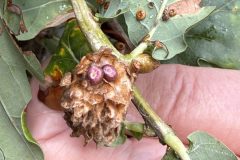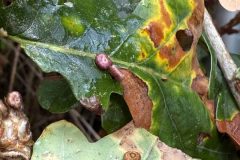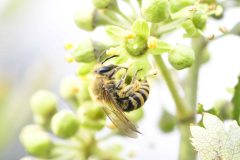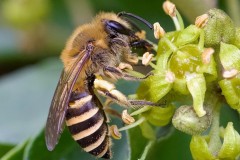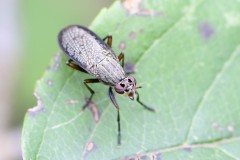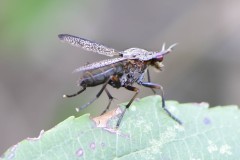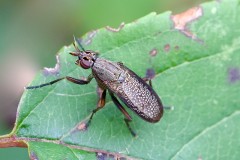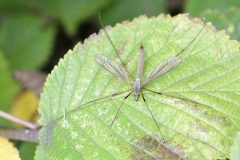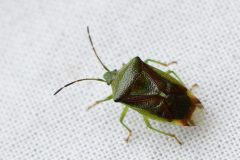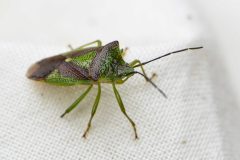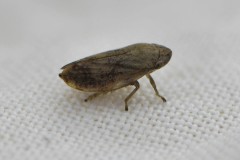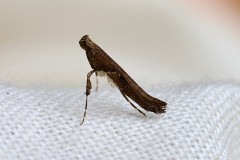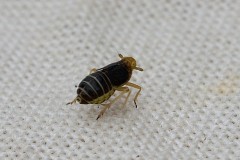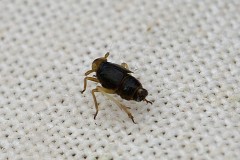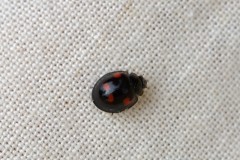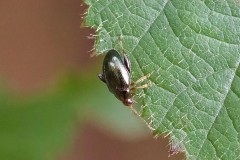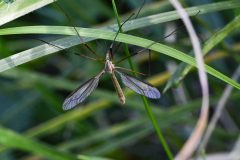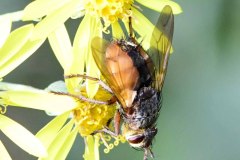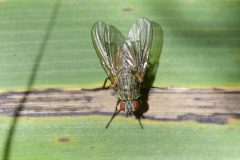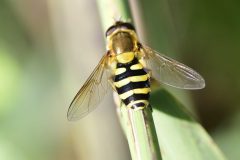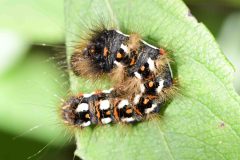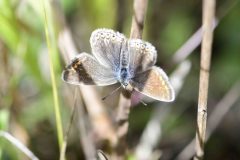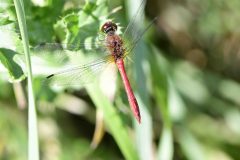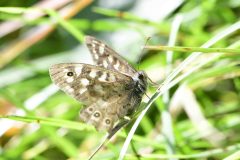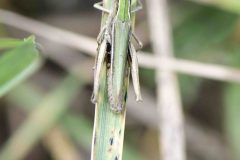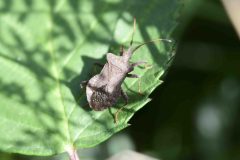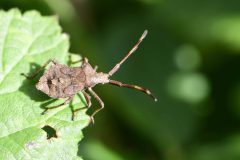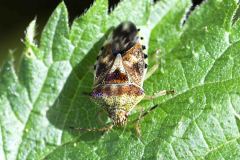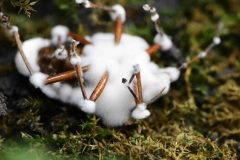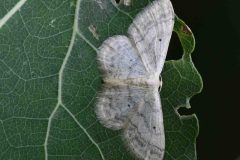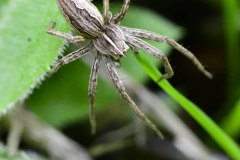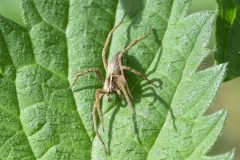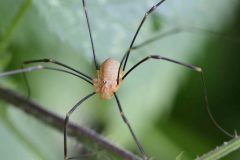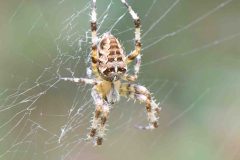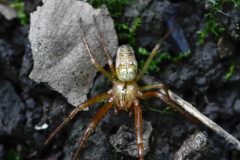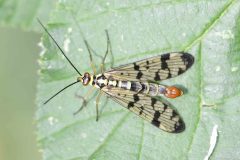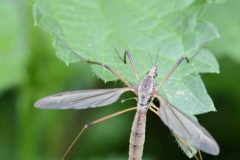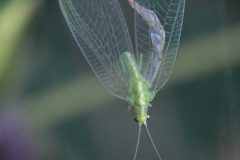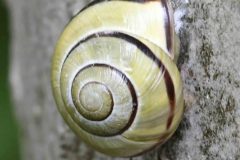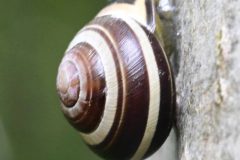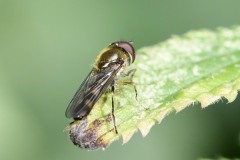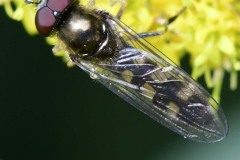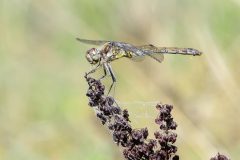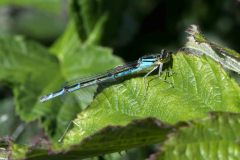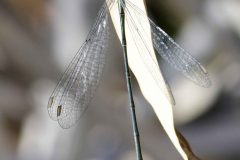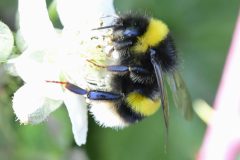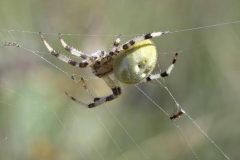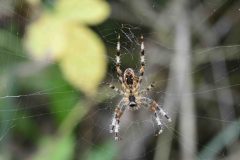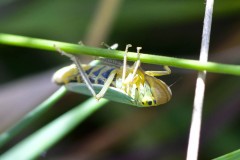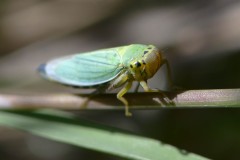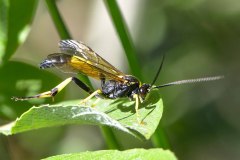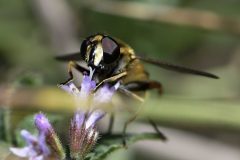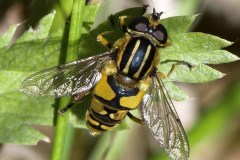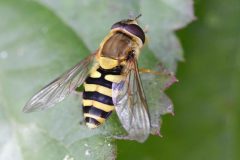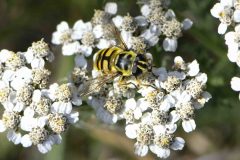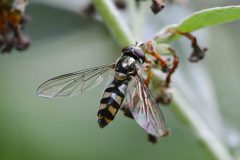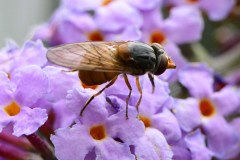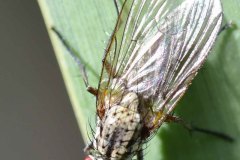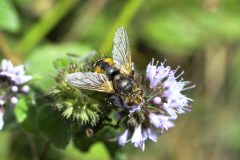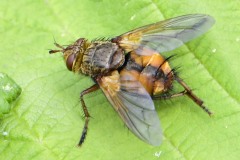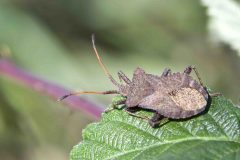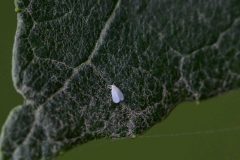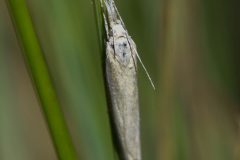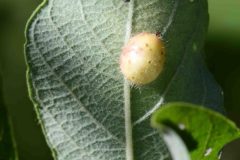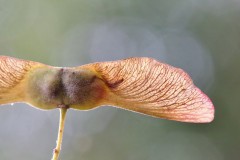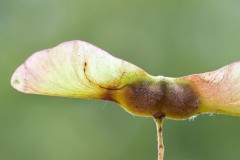Title : Plant Gall Meeting at Potteric Carr
Leader : Tom Higginbottom
Other attendees :
See here for list of plant galls recorded by Tom Higginbottom et al.
Title : Plant Gall Meeting
Leader : Tom Higginbottom
Other attendees : Les C., Samantha & Graham B., Jim B., Ian F., Colin H.
See here for list of plant galls recorded by Tom Higginbottom et al.
This was a meeting organised by the Plant Gall Society with the Sorby Society and Doncaster Naturalists’ also in attendance.
Not all the attendees were there for the plant galls as was evidenced in the gathering in the car park, as sweep nets were in evidence.
Whilst some of our members joined with the gall hunters, Samantha, Graham and I joined Jim Flanagan of the Sorby with his sweep net. Jim was very generous with his time and knowledge, describing each of the contents of his net in detail, and patiently allowing photographs to be taken of some of the interesting bugs therein.
Along the hedgerow of the footpath bordering the cricket ground, we observed several Ivy Bees (Colletes hederae) hard at work on the flowering ivy plants. These late season bees, with their ginger thoraxes and orange/yellow striped abdomens, are another of the species that are progressing northwards.
A Snail-killing fly (Coremacera marginata) was spotted by Samantha at rest in the hedge bordering a field below the sewage works. Whilst legs and eyes are reddish brown, the eyes have a distinct pattern to them.
A Cranefly, at rest low gown in the hedgerow, was found to be the September Cranefly (Tipula paludosa) rather than the more common Cranefly (T. oleracea).
A number of shieldbugs succumbed to the sweep netting, including the Hawthorn Shield Bug (Acanthosoma haemorrhoidae), Birch Shield Bug – (Elasmostethus interstinctus), and the common Green Shield Bug (Palomena prasina).
Many of the interesting specimens captured by Jim proved too small, and quick, to capture with the camera, but there were some that we managed to obtain passable images. These included the Miridae bug (Deraeocoris lutescens), a Harlequin Ladybird (Harmonia axyridis), the Alder spittle bug (Aphrophora alni), a moth Caloptilia semifascia, (another species moving northwards) a bracken specialist Ditropis pteridis, male and female, the Pine Ladybird, Exochomus quadripustulatus and a Cabbage-stem Flea Beetle, Psylliodes chrysocephala, a leaf-chewing beetle which can be variable in colour.
Les with assistance from Samantha.
Title : Conisbrough Parks (part 3) – re a solar farm application.
Leader : Colin Howes
Other attendees : Les C
Aims : To update the hedgerow survey of the Firsby Lane area undertaken by the society in 1994-95 and to provide any additional natural history observations for the area.
Results:
Les C and I met up in the Hilltop Pub for refreshment and to wait for any Nats members who were prepared to risk the forecasted rainy weather.
As things transpired, we were the only ones to venture out on what turned out to be a rather torrential afternoon. However, on route to our meeting-place, Les saw a large skein of geese flying over, so at least there was something to report.
We crossed over to Firsby Lane and spent a little time inspecting the fascinating geological origins of the Carboniferous (Coal measures) stone blocks in the side-walls of the farm outbuildings on the corner (SK494960). The Farm and its contemporary outbuildings are listed in Magilton (1977) as Grade 9 and dated as early 19th century though on the sits of a ? Medieval Manor House.
Also the rather fine parkland trees in the grounds to the rear of Toll Bar House were impressive to see.
By the time we got to the first wild hedgerow, the rain had started but our attention was arrested by the unexpected vista of a substantial flock of geese feeding in cereal stubble to the east of Firsby Lane. Looking east, the rolling arable landscape dipped into a shallow valley and it was here the geese had gathered, effectively keeping out of sight. Les counted in excess of 200, those in clear view were Canada Geese, though some of the more distant birds may have been Greylags. Also in attendance were numbers of Black-headed Gulls (100+), Lesser Black-back Gulls (6), Wood Pigeons (50+) and Carrion Crows. During the short period we watched the geese the light levels dropped as the surrounding landscape became engulfed in mist and low cloud. Clifton to the east and Micklebring and the M18 to the south were lost to sight and we, at the top end of Firsby Lane (272ft), were probably within the cloud-base, the fine misty rain penetrating everywhere.
Hoping the clouds would pass over and the rain ease, we pressed on, adding two Collared Doves, a Blackbird, a Dunnock and a Robin.
The hedgerows and canopy trees along the lane Included the following woody species:
Ash; Blackthorn; Bramble; Elder; Elm (Witch); Field Maple; Hawthorn; Holly; Hazel; Ivy; Pedunculate Oak; Rose (Dog); Rose (Field) and Sycamore. Climbers included Honeysuckle and Black Bryony and herbs included Dog’s Mercury. Banks of Bracken along the verge indicated we were on the Carboniferous sandstone of Hooton Roberts rather than Permian Limestone of Conisbrough.
Having only ventures about 600m, drenched and defeated we retreated back to the Hilltop Pub and a welcome hot drink. Here, we took the opportunity to review on an iPad, some of the recent photographs (supplied by Ian McDonald) added to the website to endeavour to put names to past members of the society.
Note: The presence of un-ploughed cereal stubble is a relatively rare sight these days and may give a clue as to the survival of Yellowhammers Emberiza citrinella and Grey Partridge Perdix perdix as reported by local residents.
Ref: Magilton, J.R. (1977) The Doncaster District: An Archaeological Survey p. 30.
A Doncaster Museum and Arts Service Publication.
CAH.
Tuesday morning meetings (9 Sept & 16 Sept.), initially arranged to pass Field Meeting reports to Les for the DNS Website and to hand over back copies of yet more YWT Newsletters and annual reports to Jennifer of Potteric Carr management, were followed by brief and productive field visits onto the reserve. Interestingly, with other friends and DNS members such as Louise & Tim; Samantha & Graham; David Carroll and Ian Heppenstall calling in, all manner of other matters were discussed, specimens and photographs identified and information passed on.
Our excursions took us again to the dried out Newt ponds at Site plan code RBSF 5-4, and Loversall Delph, the dried out pond at the entrance to Beeston Plantation and along the track around Decoy Lake, opposite the visitor centre.
CAH & LC.
The following invertebrates are additional to those listed in the previous report.
Title : ‘Tickhill Town Stroll’
Leader : Colin Howes
Other attendees : Jim B.; John N.; Samantha & Graham B.; June B.; Les C.; Derick A.; Tom H.
Aims: To examine some of Tickhill’s Ginnels and Snickets, the limestone walls of St Mary’s Road, the Mill Pond and Castle area, looking for wall ferns and other wall-dwelling plants.
Preface : All walls mentioned are of the local Permian Magnesian Limestone. Due to the prolonged spring and summer drought and the late date of our visit, most of the wall ferns and wall dwelling (mural) flowering plants were reduced to struggling, desiccated or dead clumps or sprigs. However, ground-dwelling flowers still in bloom were attracting late season migrants such as Painted Lady Butterfly Vanessa cardui and Hummingbird Hawkmoth Macroglossum stellatarum.
Route : as follows:-
- We proceeded to the southern portal of the Ginnel next to Brook House [Brook House Ginnel] off Lindrick at SK5890 9278 DN11 9RD.
- We proceeded north along Brook House Ginnel, crossing the Paper Mill Dike and emerged between 73 & 75 (Mulberry Cottage) on West Gate at SK5888 9290 DN11 9NQ. Here we found the largely desiccated clumps of Annual Wall-rocket Diplotaxis muralis (6 clumps); a couple of clumps of Greater Celandine Chelidonium majus; Ivy-leaved Toadflax Cymbalaria muralis (3 clumps); Maiden-hair Spleenwort Asplenium trichomanes (64+ clumps); Hart’s-tongue Fern Asplenium scolopendrium (2 clumps); Male Fern Dryopteris filix-mas (1 plant); and Polypody Fern Polypodium sp. (1 plant). On the end wall of the Brook House walled garden, overlooking Paper Mill Dike, were 11+ more clumps of Maiden-hair Spleenwort. Interestingly, a fine display of cultivated ferns was in the garden of Mulberry Cottage overlooking the Dike. These may have been the sources of some of the adjacent wall flora.
- We walked east along West Gate (A60) and turned north up Church Lane where in the sunshine we were entertained by the chattering calls of a group of the local House Sparrows. On a long limestone garden wall were 3+ clumps of the cultivated Wall Bellflower Campanula muralis and one of Snow in Summer Cerastium tomentosum.
- We proceeded to St Mary’s Churchyard at SK5914 9304, walking round the outside of the churchyard, recording plants across New Road, finding Male Fern (2 plants); Wall Rue (13 clumps); Hart’s-tongue Fern (2 plants); Maiden-hair Fern (2 clumps). Rosebay Chamaenerion angustifolium (3 plants); Buddleja Buddleja davidii (1 plant).
- We joined St Mary’s Road at SK 5918 9314.
- On the front wall of No.1. St Mary’s Road was Maiden-hair Spleenwort (10 plants); Wall Rue (3 plants); a Viola (1 plant); and Yellow Sorrel Oxalis corniculata (1 plant).
- On the perimeter wall of St Mary’s C. of E. School were 61 + clumps of Maiden-hair Spleenwort.
- On the east side of St Mary’s Road, by a derelict brick and pantile building, a bed of blooming Red Valerian Centranthus rubra had attracted at least one Painted Lady Butterfly Vanessa cardui and a Hummingbird Hawkmoth Macroglossum stellatarum.
- We proceeded north along St Mary’s Road to the west end of Drury Lane ginnel (SK5916 9327 DN11 9NA).
- Along Drury Lane we noted Wall Rue (33 clumps, including 8+ below a leaking guttering); Ivy-leaved Toadflax (13 plants); Buddleja (3 plants); Red Valerian (3 plants); a cultivated Strawberry Fragaria × ananassa (1 plant) and a Stonecrop Sedum (1 plant).
- After chatting to a local resident on the subject of Ginnel nomenclature, we emerged at the east end of Drury Lane onto Market Place (between Browns bakery shop & Weldricks Pharmacy) at SK5925 9328 DN11 9HT.
- We crossed Market Place opposite ‘Spa’ to the north side of Sunderland Street (A631).
- On crossing the road, we first paused to inspect the impressive oval bronze plaque erected (26 June 2002) to commemorate Queen Elizabeth II Golden Jubilee (50-years). The plaque is mounted on a substantial block of Magnesian limestone from the quarries at Stainton. The Hilary Cartmel/Johnson Studio in the nearby village of Styrrup cast the plaque. It depicts various sites and scenes connected with the town’s history. These include: The Buttercross, Parish Room/St Leonard’s Hospital, Scarbrough Arms Inn, Evangelical Church, Public Library, Tickhill Castle Gatehouse, St Mary’s Parish Church, Methodist Church, Mill Dam along with the major thoroughfares of Northgate, Sunderland Street, Castlegate and Westgate.
From an ecological point of view, we noticed that since June 2002 the limestone has weathered and become mottled, colonised by microscopic algae and tiny colonies of lichen. However, no such colonisation had occurred on the limestone beneath the plaque, indicating that rainwater running down the bronze had picked up copper ions (Cu2+) toxic to any algal and thus lichen growth. [Bronze is primarily an alloy of copper and tin but can also contain aluminium, manganese, nickel, zinc, and phosphorus].
- Behind a structure (bearing the code FP0320) on Sunderland Street (SK59285 93298) built against the street wall was a healthy growth of Black Spleenwort Asplenium adiantum-nigrum full of spores.
- We walked east to Tithes Lane where we proceeded north along the lane.
- On the east-facing wall were 27 clumps of very desiccated Ivy-leaved Toadflax and 1 of Wall Rue.
- At Oakwell (Bungalow) (SK5937 9336 DN11 9QN) we turned right into the long narrow ginnel, passing allotments on the left and on to Tickhill Cricket Club (SK 5960 9334), emerging onto Alderson Drive at SK59649330 DN11 9QJ).
- Being largely flanked by fencing or hedgerows, this Ginnel was generally not suitable for our target species. However, on the garden wall of Oakwell, from a single sprig (!), Graham & Samantha B identified a Himalayan Honeysuckle Leycesteria formosa, sporting a single white flower. At the intersection of Scarbrough Court, June B drew our attention to a patch of amenity grassland with a population of Orange Hawkweed [Fox & Cubs] Pilosella aurantiaca.
In the grounds of the cricket club, John N notices a late group of hirundines (possibly House Martins) hawking over the surrounding tree canopies.
- We crossed Alderson Drive to the waste bin at Boundary Cottage (SK59679331) and turned right down the Ginnel, passing south to Sunderland Street, emerging beside No. 54 at SK5967 9324 DN11 9PU.
- Here we found Male Fern (5 shrivelled clumps); Hart’s-tongue Fern (5 clumps, some with crimped leaf edges); Polypody Fern (3 tiny shrivelled plants); Ivy-leaved Toadflax (10 clumps); Purple Toadflax Linaria purpurea (16 plants); St John’s-wort Hypericum (16+ shrivelled unidentified plants).
- Return: After a coffee and bun at “H’s Café” we proceeded south along Castlegate, and at the junction with Castle Close we encountered a fine Black Walnut Juglans niger, with its curious brownish-green plum-like fruit. Despite being of the Juglans genus, Tom could find no plant galls as is usual for the Common Walnut.
- We continued south via Tickhill Castle & Mill Pond (SK5924 9284 DN11 9QQ) where on the limestone wall along the castle moat we encountered Wall Rue (24 clumps); Maiden-hair Spleenwort (1 clump); Hart’s-tongue Fern (1 clump); Ivy-leaved Toadflax (13 clumps); Pellitory-of-the-wall Parietaria officinalis (7 clumps); Garlic Mustard Alliaria petiolata (2 clumps); Dead-nettle Lamium (5 clumps) and Canadian Fleabane Erigeron canadensis (1 clump).
- We crossed over to Dam Road, joining the Ginnel adjacent to Tickhill Mill Field (SK5912 9284). Here, the limestone wall on our left seemed devoid of vegetation. However, we encountered a Dunnock and a Robin in the hedgerow beside the Mill Field.
- We emerged onto Lindrick at the Mill Beck (SK5907 9270) where Hart’s-tongue Fern was growing in the wall and of all things a flowering Perennial Sunflower Helianthus rigidus was growing from a clump of debris in the fast-flowing beck.
- Here we crossed Lindrick Road to the farmstead where Derek A. regularly works, introducing us to a menagerie of 2 Miniature Shetland Ponies, 2 Miniature Goats, a distant population of sheep and various feathery-footed chickens, pheasants and ducks. We noted that the nettles around the chicken enclosure were the less common but more painful (if stung), smaller, annual Small Stinging Nettle Urtica urens.
- At the junction of Lindrick, Lindrick Lane and Water Lane was a Chestnut tree, identified by its less spikey conker cases as Red Horse Chestnut Aesculus x carnea [the hybrid between the Common Horse Chestnut hippocastanum and the American Red Buckeye A. pavia].
- In returning along Lindrick to our parked cars, the fruiting branches of another plant of fascination flaunted themselves over a high garden wall. These bore the papery seed pods of the Bladder Senna Colutea arborescens.
Total distance: 2.89km or 1.8 miles.
Acknowledgements: Many thanks to Trish Haigh and Jim Burnet for providing the inspiration for this new adventure and to Derek Allen for introducing us to the fascinating menagerie of farm animals he so conscientiously tends in Tickhill.
OS Grid references and Post Codes were located via https://www.cucaera.co.uk thanks to Tim & Louise.
CAH & LC.
Hortus Muralis, the final score.
In our 1.8 mile walk round Tickhill which included visits to four of its Ginnels, we noted 387 clumps or individual plants of 25 *taxa growing on or out of walls.
Of the ferns we noted 247 clumps or plants of 6 native taxa, the most frequent being Maiden-hair Fern Asplenium trichomanes.
Of the flowering plants we noted 140 clumps or individual plants of at least 19 taxa, the most frequent being Ivy-leaves Toadflax Cymbalaria muralis.
*In that not all plants could be identified to species, the term taxa has been used when quantifying the types of plants.
Table 1: Taxa listed in order of frequency.
| FERNS (6) | (247) | |
| Maiden-hair Spleenwort | Asplenium trichomanes | 149 |
| Wall Rue | Asplenium ruta-muraria | 74 |
| Hart’s-tongue Fern | Asplenium scolopendrium | 11 |
| Male Fern | Dryopteris filix-mas | 8 |
| Polypody sp. | Polypodium sp. | 4 |
| Black Spleenwort | Asplenium adiantum-nigrum | 1 |
| FLOWERING PLANTS (19) | (141) | |
| Ivy-leaved Toadflax | Cymbalaria muralis | 66 |
| Purple Toadflax | Linaria purpurea | 16 |
| St John’s-wort | Hypericum sp. | 16 |
| Pellitory-of-the-wall | Parietaria officinalis | 7 |
| Annual Wall-rocket | Diplotaxis muralis | 6 |
| Dead-nettle sp. | Lamium sp. | 5 |
| Buddleia | Buddleja davidii | 4 |
| Wall Bellflower | Campanula muralis | 3 |
| Red Valerian | Centranthus rubra | 3 |
| Rosebay | Chamaenerion angustifolium | 3 |
| Garlic Mustard | Alliaria petiolata | 2 |
| Greater Celandine | Chelidonium majus | 2 |
| Fern-grass | Catapodium rigidum | 1 |
| Snow in Summer | Cerastium tomentosum. | 1 |
| Canadian Fleabane | Erigeron canadensis | 1 |
| Cultivated Strawberry | Fragaria × ananassa | 1 |
| Himalayan Honeysuckle | Leycesteria formosa | 1 |
| Yellow Sorrel | Oxalis corniculata | 1 |
| Stonecrop sp. | Sedum sp. | 1 |
| Violet sp. | Viola sp. | 1 |
| Fern-grass | Catapodium rigidum | 1 |
A boundary between the prevailing uses of certain vernacular terms is referred to as an Isogloss. Examples being the divisions between the prevailing uses of the regional terms for Alleyways such as “Ginnels” and “Snickets”.
“Ginnel” can be pronounced with either a hard G (as in “Gin-uhl”), or a soft G (as in “Gen-uhl”).
[Dr Google advises us that the hard G sound is evidently common in areas influenced by northern cities, such as in Manchester, Sheffield and Leeds, while the softer G is used in some other parts of the UK].
Further, the lady resident we spoke to in Drury Lane used the even softer “Jen-uhl” version.
A variant “Vennel” is evidently used in the north-east, including County Durham and Scotland.
The term “Snicket” also refers to a narrow passageway or cut-through between buildings. It is a popular term in north eastern areas. My family used it exclusively in Scarborough and the Wolds villages and I understand it was (is) used in Cleveland and County Durham. When I worked in Exeter, Devon (mid 1960s), the common term for an alleyway was an “Ope”, [probably a diminutive of opening], or a “Drangway” (CAH).
Anyone with experience of regional terms for alleyways pleas pass them to our website or Facebook page.
CAH.
Title : Thorne Community Woodland and ponds (formerly Bunting’s Wood). Grid ref. SE681131 & Postcode DN8 5EP
Leader : Colin Howes
Attendees : Nora B; Margaret P; Jim B; John C; Les C:
Objective : It is hoped to become familiar with the site and provide preliminary species information for the Local Authority Biodiversity Database.
Background: Thorne Community Woodland (Formerly Bunting’s Wood) was developed as mixed deciduous woodland over former grass/arable land. The Stainforth Keadby Canal forms its northern boundary and Thorne Golf Course forms most of its southern boundary. It is intersected (north-south) by the embankment of the Hull/Doncaster railway line and is crossed by the six elevated lanes of the M18. The site includes three ponds (two of which, Perch’s Pond & Sammy Roy’s Pond, are borrow pits associated with the railway embankment) all with good aquatic insect and herptile populations including Great Crested Newts. The third pond (Crayholes pond, an ex clay-pit) is the type locality for the algae (filamentous cyanobacteria) Lyngbya thornensis, a species described new to science by William Bunting and W.G. Lund (The Naturalist (1956) (July-Sept): 1-3).
Thorne Community Wood is supported by a volunteer Friends group which maintains, develops and promotes the site. Founded in 1994, they work closely with the wood’s landowners (Thorne- Moorends Town Council). They are also linked with the Forestry Commission, The Woodland Trust and Natural England and undertake practical conservation/habitat management work.

Conditions: The site is low lying, flat and served by a grid of woodland rides. Due to the prolonged spring and summer drought, the ground was exhibiting deep fissuring. Non the less, due to the clay nature of the soil, recent downpours had left large puddles in the car park.
Objectives: The aim was to become familiar with the site and provide preliminary species information for the Friends of the Community Woodland and the Local Authority Biodiversity Database.
Route & Results: From the car park (SE680 131), the survey group followed the northern perimeter path (between the plantation and the canal embankment) east to the railway embankment (SE678 132). We then turned south, connecting with the roadway passing under the railway bridge (SE6768 1313). Here we exited compartment 6 and entered compartment 4, stopping a while at Perch’s Pond (SE6764 1317). Here CAH detoured north along an overgrown path to visit Crayholes Pond (SE677 132) (not visited since the early 1970s). The group then proceeded further along the main footpath towards the canal bank (SE675 132) before returning to the railway bridge and returning to the car park via the arterial vehicular track.
The species recorded and photographed are listed in alphabetical order according to their taxonomic classification in Table 1.
Acknowledgements: I would like to thank the DNS members for their records, observations and photographs and for making it such a pleasant and interesting occasion. Thanks are also due to Les Coe for finding and inserting the very useful site map.
CAH.
P.S. I remember visiting the ponds with Peter Skidmore of Doncaster Museum and local environmental campaigner William Bunting, in the early 1970s and finding a range of aquatic creatures including the Great Diving Beetle Dytiscus marginalis, Water boatman Notonecta glauca, Water Scorpion Nepa cinerea, Water Slater Asellus aquaticus, Great Pond Snail Linmnaea stagnalis, Great Ramshorn Snail Planorbis corneus and a range of Damselflies. CAH
Table 1. A Preliminary list of Species recorded at Thorne Community Woodland (areas 4 and 6) 6th September 2025.
Title : For a coffee & a look around a very dry Dragon Fly pool.
Leader : Colin Howes
Other Attendees : Les C, Samantha & Graham B.
A meeting, initially arranged to hand over YNT/YWT Annual Reports and Newsletters of the 1960s. 70s, 80s, & 90s from the Nats Archives to the management of Potteric Carr; for CAH to pass digitised texts to Les for the Nats website; and to inspect transcriptions by Les of early 20th Century handwritten minutes from Doncaster Nats Archives, took place at 10.30am in the café at Potteric Carr Nature Reserve. This event developed into a brief and productive field visit when Samantha and Graham B. arrived. In fact, Trisha H. and family were also visiting the reserve at the time.
Our excursion took us to the Newt ponds and Loversall Delves pond dipping site (SE588003) to look for Dragonflies or invertebrates of any kind, while conditions remained sunny. The prolonged drought had desiccated all the minor still water bodies, except for the south end of the Loversall Delves, where the remaining pool of open water was a-whirl with the gyrations of a gathering of whirligig beetles (Gyrinidae) probably Gyrinus substriatus). An attractive feature here was the show of emergent flowering spikes of Unbranched Burr-reed Sparganium emersum.
The Newt Ponds were dry enough to walk across, and to get amongst the Purple Loosestrife Lythrum salicaria; Water Mint Menta aquatica; Marsh Pennywort Hydrocotyle vulgaris; Reedmace Typha latifolia; Grey Clubrush Schoenoplectus tabernaemontani and grounded Broad-leaved Pondweed Potamogeton natans.
The following invertebrates were photographed by LC:-
Aranea (Spiders etc.) Garden Spider Araneus diadematus; Four-spot Orb-Weaver Araneus quadratus
Hymenoptera (Bees & Wasps) Bumble Bee Bombus terrestris/lucorum; Ichneumon Wasp Dusona falcator.
Diptera (Flies) A Hoverfly Syrphus ribesii; Footballer Hoverfly Helophilus pendulus; Batman Hoverfly Myathropa florea; A Hoverfly Meliscarva auricollis; Hineken Hoverfly Rhingia rostrate; A root-maggot fly (Anthomyiidae) Phorbia sp.; A Caterpillar parasite fly (Tachinidae) Tachina fera; A Cranefly (Ptychopteridae) Ptychoptera contaminata.
Odonata (Dragonflies & Damselflies) Common Darter Sympetrum striolatum; Common Blue Damselfly Enallagma cyathigerum; Willow Emerald Damselfly Chalcolestes viridis;
Hemiptera (Bugs) A Dock Bug (Coreidae) Coreus marginatus; Green Leafhopper(Cicadellidae) Cicadella viridis; A White-fly (Aleyrodidae) Possibly Trialeurodes vaporariorum; Woundwort Shieldbug, (Pentatomidae) Eysarcoris venustissimus.
Lepidoptera (Butterflies & Moths) Phyllocnistis xenia leafmine on Grey Poplar, (Populous canescens); Stigmella aceris leafmine on Field Maple, (Acer campestre); Etainea louisella mine on samara of Field Maple, (Acer campestre); and a Grass Moth sp.
CAH.
